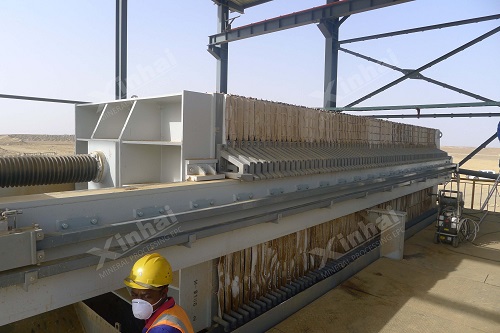What are the advantages and disadvantages of the most commonly used mechanical technologies for tailings dewatering on the market today? Let's take a closer look at some of the more commonly used products.
The tailings are concentrated to a paste consistency and then pumped for mine backfill or surface paste treatment. To achieve this consistency, paste thickeners usually have a deep cone design. It requires a considerable dose of flocculant and must be equipped with a high torque drive head to enable the rake mechanism to move in a deep bed of solids. Pumping costs are often high because positive displacement pumps are required for slurry discharge. A high degree of supervision is required to maintain bed depth and underflow consistency.
Filter presses incorporate embedded or chamber/groove plates in their design. It uses high filtration pressure to produce a dry solid cake. Filter presses, when properly regulated, provide excellent solids capture, but involve batch operation consisting of several steps. Modern filter presses can be equipped with cloth shaking mechanisms, automatic cloth washing devices, etc. to reduce man-hours in this labor-intensive process, but the installation costs are high. Even with these features, filter cloths can become clogged with fine clay particles, resulting in prolonged filtration cycles and filter cloth wear. Modern filter presses are expensive due to their large footprint and additional features.
A belt filter press achieves filtration by passing a pair of filter cloths and filter belts through a roller system with the tailings solids sandwiched between the two filter cloths. Belt filter presses have low energy requirements and are easy to operate. However, belt presses have a large footprint and require frequent maintenance and cleaning. Due to its limited production capacity (a 3m x 3m belt press can dewater 20-25 t/h dry basis solids), the number of units required for tailings dewatering is high, resulting in high capital expenditures . Belt presses require large doses of flocculants to dewater the clay-rich tailings. At the same time, a large amount of wash water is required to keep the filter cloth clean, thereby increasing its operating costs.

Solids bowl centrifuges consist of a horizontal bowl with a scroll conveyor inside, collectively called a rotating assembly. The assembly rotates at high speed around its own axis, creating a high centrifugal force that separates the tailings solids from the liquid. The separated solids are rolled off the conveyor in the form of a dry solid cake, while the clear liquid (centrifuge) overflows the weir plate at the other end. In some tailings dewatering applications, centrifuge technology requires the right amount of flocculant, but the highest unit capacity per footprint. In addition to having relatively low CAPEX, OPEX is also favored for its high throughput and low lifecycle costs.
© 2021 Yantai KZ Mining Processing Technology & Equipment Inc.